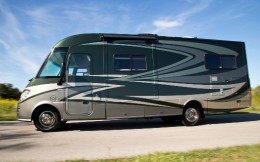• The picture quality of LCD TVs is very good;
• LCD TVs are not huge like the TV of earlier days;
• LCD TVs are very thin and can be mounted on walls;
• LCD TVs can also be mounted on motorized bases that can be retracted when not in use.
However, many RV owners, who reside in the Frost Belt, hesitate to invest in an LCD unit, as the general belief is these ultra-slim television sets might not be able to handle the freezing temperature well.

So, what makes the LCD TVs vulnerable to the freezing temperatures? It is their very make. The LCD TVs have a liquid crystal fluid in their display which,, like any other liquid, can freeze in extremely cold conditions. Moreover, when you allow this liquid to freeze it may expand, distort, and even crack. All these factors make LCD televisions extremely vulnerable in the freezing cold. But, this does not mean that you cannot install one in your RV to lure buyers from up north. Simply know how to use it carefully and pass the knowledge to your prospects.
What is the Safe Operating Temperature for LCD TVs?
Certain conditions can harm the LCD display. For example, when you bring a cold LCD TV is cold to a warm environment there will be moisture throughout the device due to condensation. Plugging it in and turning it on in such a condition can cause catastrophic results like short circuits, shocks, and ultimately, failure of the unit. Ideally, you should store an LCD TV in temperatures ranging between 40 degrees and 100 degrees Fahrenheit in order to keep the liquid crystal fluid from freezing. But, if your LCD TV is exposed to an environment below this temperature range, give it some time, at least 24 hours, so that it can adapt to the suitable temperature range, after which you can plug it in and turn it on without causing it any harm.
How Can You Protect Your LCD TV?
Here are some safe-storage tips that you can share with your prospective buyers:
Step 1:
Cover your TV with a blanket or wrap it with a cardboard sheet so that you cover the screen completely. This will not only protect the screen from the cold but will also protect it from scratches while it is in storage.
Step 2:
Different manufacturers provide different temperature limitations for their products, but none has a temperature limit lower that minus 20 degrees Fahrenheit. So, it will be a wise decision to store your TV above minus 20 degrees Fahrenheit.
Step 3:
You may also remove your LCD TV from the RV and store it indoors in warmer temperatures. You can also arrange for heated storage options for your RV during the winter months.
The installation of an LCD TV will considerably help you to sell your RV online. Remember to highlight this feature in the ad that your post. Throw in your two cents about LCD maintenance and impress your buyers in no time.













